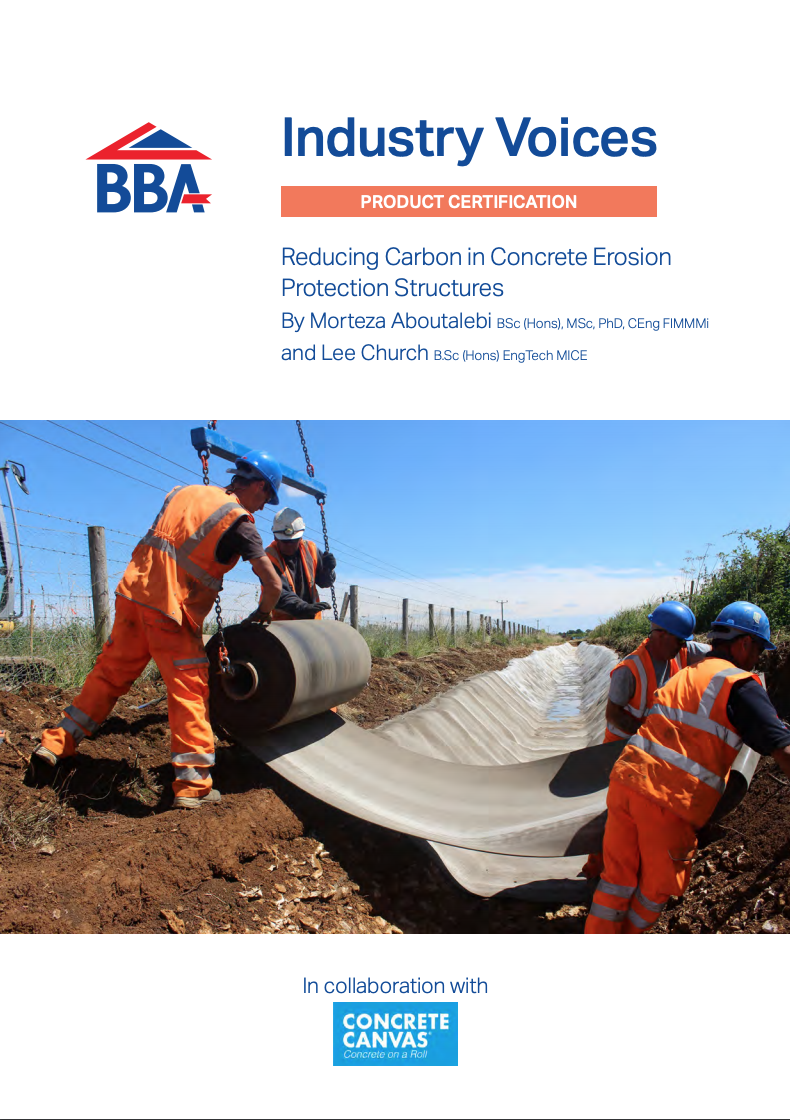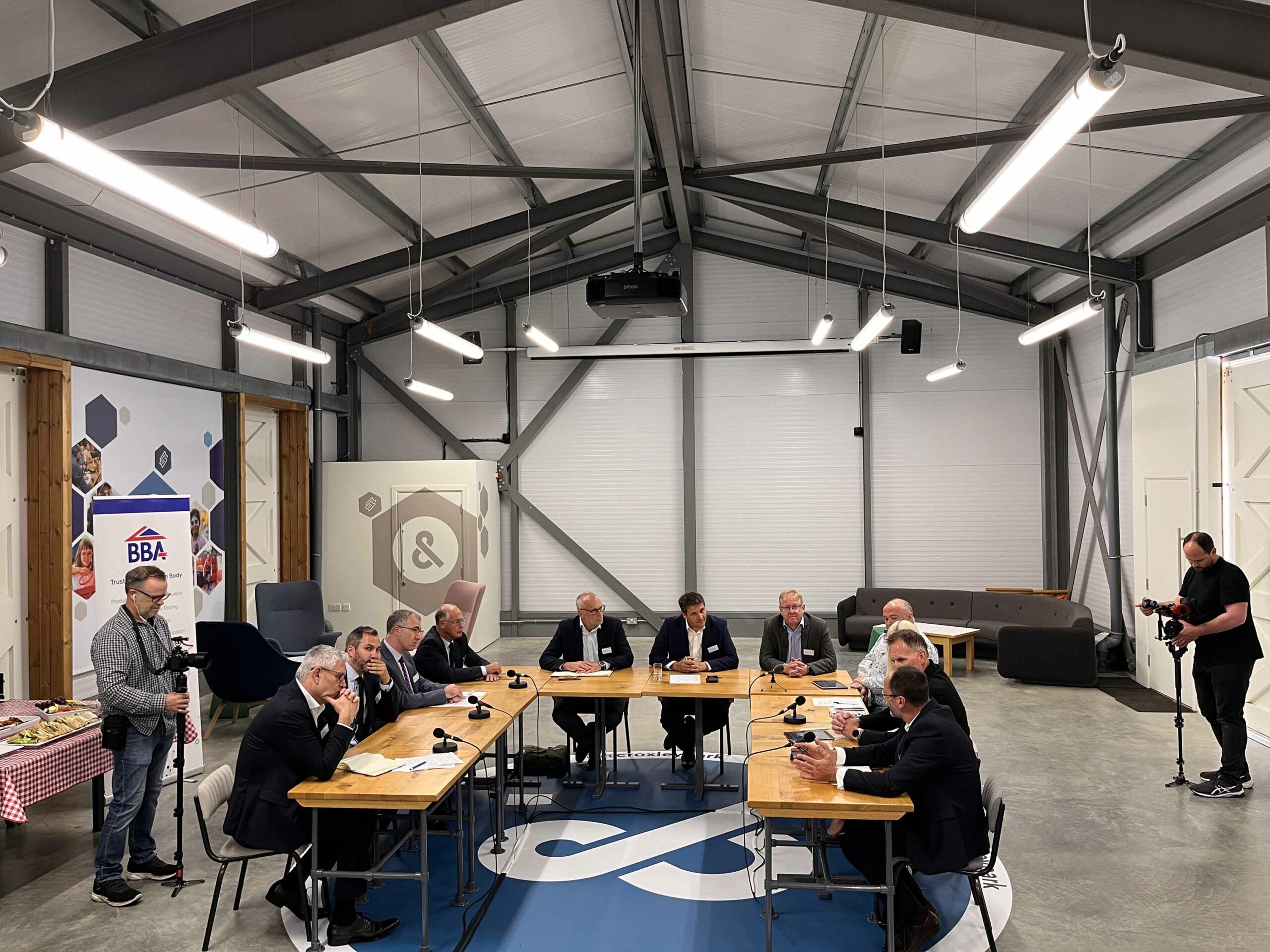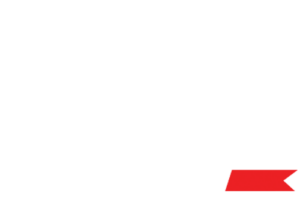How can organisations that feel they are behind in their adoption of new practices, technology, digital strategies and new methods of construction, start to drive the changes needed to stay competitive?
How can organisations that may feel they are behind in their adoption of new practices, including technology, digital strategies, and new methods of construction, start to drive the changes needed to stay competitive?
Speaking at the BBA’s Round Table discussion, Hardy Giesler BBA Chief Executive Officer, Richard Waterhouse BBA Non-Executive Director, Craig Smith Industry Lead / Convenor of City & Guilds, Jason Cureton Founder of Insulfix Ltd, David Johnson Technical Director of DGuage Ltd, Colin Johnson Managing Director of DGuage Ltd, Richard Smith Head of Products & Innovation of NHBC, Adam Turk Chief Executive Officer of Siderise Group Ltd, Antony Brophy Director of Business Development UK at CoBuilder and Emma Wiles BBA Sales & Marketing Director, shared their views.
Watch Part 2 of 5: BBA Roundtable – Driving change to stay competitive through Technology Adoption
Richard Waterhouse, BBA:
“I think the industry is very well-positioned to improve – to make advances in both technology and in the ways we systemise construction. Obviously, over the last few years, we’ve been tested quite heavily by Covid, and we’ve seen and learnt things we’ve never expected from that. For example, having fewer people on a construction site actually improved productivity because people weren’t getting in the way of each other. I think we have to re-think how we deliver construction. We have lots of opportunities for doing that: modularisation, off-site construction etc. But underpinning all of this is a change of our culture. And that’s where we still have a problem. We have lots of technology to help with information management. We have innovative products and systems, but we have to have the desire to change”
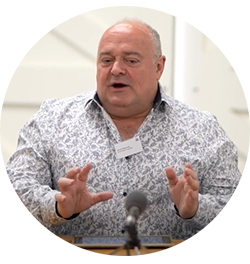
Jason Cureton: Insulfix
“I think companies have a few dilemmas they’re facing. IT may be alright using new technologies, but the question remains how are they maintained on site. Do they need to provide additional training? I feel that the impression is probably the people on site are a bit neanderthal in their methods because nothing has changed. We’ve been putting one brick on top of another for years, and nothing has really changed. So for the person on site to take on new technologies – it needs to be adopted, but it needs to be driven by the Manufacturers who need to make a bigger stand in training those who use it, to recognise the benefits of their product”.
“I think products need to be developed by talking to people at the cold-face, and speak to the people who use the products and take their feedback around how products need to be developed; especially when it comes to ease of installation. If it’s not easy to install, the product’s potential won’t be maximised.”

Emma Wiles: BBA
“I think there’s an ownership and accountability throughout – from an end-to-end perspective. It’s important that its something that is shared and acknowledged throughout. The challenge then comes in making those changes, when you have a lot of stakeholders involved in making sure that the one thing that everyone is trying to achieve is done well and adopted throughout the process. For those who feel that they’re lagging behind, it’s about starting the process, but thinking about the future. So, rather than trying to catch up where you think you’re behind now, it’s thinking about the next step and how do we head towards the direction for the future.”
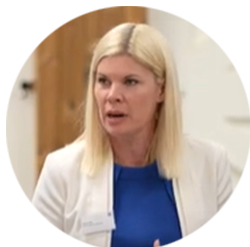
Colin Johnson: DGuage
“It’s about how we measure whether we’re behind or not; and what we’re trying to achieve. Perhaps its identifying a clear way to document where we are in the journey. You have to hear from the people on the cold-face doing the job, to understand how something would work, and how technology would best solve that problem. That’s what it’s trying to do. From our industry, there’s often a problem and a tool to solve it. And there may be a number of solutions to any problem. I think it’s about speaking to people trying to solve the problem to try various permutations to solve it. It’s about matching people together, and putting people on site to see how the proposed solution may solve the problem; it will certainly change the way we design products digitally”
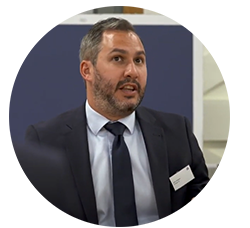
Adam Turk: Siderise Group
“If you want to catch up, you have to have a desire to do that; and that’s got to come from the top of the business first and foremost. But what the business then has to do is understand that the new technologies that they’re looking at often require a different skillset. They have to be willing to acquire that skillset and be willing to invest in resource. You can’t take your existing team that has always worked in a particular way, and suddenly give them new technology to develop. You have to bring that skillset in. You see a lot of companies not really grabbing hold of that. But if you can do that, and you can resource it properly, you can fast-track where you want to go. You need to really take on board the voice of the customer, you need to understand the people that will be using the technology, they need to be on-board with that.”

Hardy Giesler: BBA
“You really have to want it. I spend a lot of time reading outside of work, and a lot of it is about technology because I really enjoy it. But I have come across people in business, Richard (Waterhouse) is one person, who has led NBS through a digitisation project very successfully, and Richard just has digitisation in his veins. In terms of digitisation and modernising and looking at things in different perspectives. It’s not in incremental steps, it’s just a different way of doing things. And if you’ve been through that process before, it’s incredibly valuable. Having said that, we’ve also found people within our business in more junior roles, who in their own time are learning how to read and write code, who have suddenly stepped up and done 100s of hours of work in their spare time and come to us with an offer in which we’re now adopting across the business. There are some phenomenal surprises for us. And what is driving all of this, for us, is obviously our clients but also the end-users who read the information. BBA traditionally presented the market with a pdf of 20 – 30 pages with a lot of technical information, and we expected an architect and a contractor on site, and the entire audience in between, to all gain maximum benefit from one single document in one format, delivered through one particular medium. That is just not fit for purpose. So that is what’s driving us.”
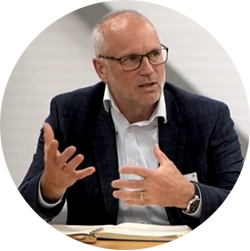
Craig Smith: City & Guilds
“It’s a really interesting point this. There’s been mention of training as a solution. I think Training has become a bit of a dirty word nowadays. The industry is moving towards more blended solutions. But I think ultimately, if a company has a new technology product, and part of that proposition is ‘to deploy it with X number of hours with people and indirect time and cost’ etc, it’s just not going to work. It’s really important to think about how we develop the skills that people need to deploy the technology. The tech needs to be intuitive from the beginning. It’s not about taking people away from work, but rather how people learn in the flow of work. As they’re deploying and using this new technology, there are tools to help support them through what should be an intuitive process anyway.”
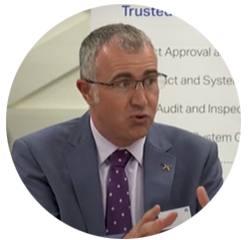
Antony Brophy: CoBuilder
“What I see a lot of the time, and what I’ve experienced myself working for main contractors, is the understanding on who has the handle on the main technology, are they looking at the bigger picture of that company. Quite often peoples’ day-jobs get in the way, and sometimes things don’t end up happening and you push back innovation to the next project. I think you need to assign people the role for what they’re looking at, have an understanding of the entire business. Get a team together that can implement things quickly and be agile about it. The core is that they need to understand business; and look at how things are understood and implemented”.
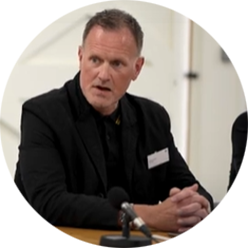
Richard Smith: NHBC
“Agility and adaptability to the pace of change varies from builder to builder. You see natural leaders leading the trend, and those that follow and who are potentially a bit more resistant. With technology, we’ve been doing a lot work around climate change, and you can treat climate change as a subject, or you can embed it into what you do on a day-to-day as a process; it is the same with technology. In my view, it’s not about having technology projects, but rather about technology maintenance as you go along. I think that sometimes one can go down a route of doing a project, and as soon as you finish the project, you’re out of date again. The key thing is the aspect of maintenance to evolve your technology within your business as opposed to a stop-start approach.”

David Johnson: DGuage
“I think it’s difficult to extract the technical from the business side of things in reality. I look at it from the point of view that the technical and the business are very closely linked. I think one of the key things is that if you’re a company and you feel you’re not getting into the field quickly enough, you have to look at it from the point of view that it will be the bottom line that probably tells you. If you’re in that situation, looking at it from the top-down, you start to do things that will enable you to make things happen. As other participants have mentioned, the key thing is looking at your team to identify whether you have the right people in the team to enable this to happen. If you don’t, how are you going to bring it into the business. In our business, I look at a lot of the younger people in our business who are native digitally; they can tell me a lot more about the technology that’s usable and evolving – but they don’t require an instruction manual, like I would! You need to have the right people in place, with the right skillset and champions who will bring that forward. We shouldn’t be scared to select people to champion things in our business.”

Share This Story, Choose Your Platform!
Related Roundtables
How can organisations that feel they are behind in their adoption of new practices, technology, digital strategies and new methods of construction, start to drive the changes needed to stay competitive?
How can organisations that may feel they are behind in their adoption of new practices, including technology, digital strategies, and new methods of construction, start to drive the changes needed to stay competitive?
Speaking at the BBA’s Round Table discussion, Hardy Giesler BBA Chief Executive Officer, Richard Waterhouse BBA Non-Executive Director, Craig Smith Industry Lead / Convenor of City & Guilds, Jason Cureton Founder of Insulfix Ltd, David Johnson Technical Director of DGuage Ltd, Colin Johnson Managing Director of DGuage Ltd, Richard Smith Head of Products & Innovation of NHBC, Adam Turk Chief Executive Officer of Siderise Group Ltd, Antony Brophy Director of Business Development UK at CoBuilder and Emma Wiles BBA Sales & Marketing Director, shared their views.
Watch Part 2 of 5: BBA Roundtable – Driving change to stay competitive through Technology Adoption
Richard Waterhouse, BBA:
“I think the industry is very well-positioned to improve – to make advances in both technology and in the ways we systemise construction. Obviously, over the last few years, we’ve been tested quite heavily by Covid, and we’ve seen and learnt things we’ve never expected from that. For example, having fewer people on a construction site actually improved productivity because people weren’t getting in the way of each other. I think we have to re-think how we deliver construction. We have lots of opportunities for doing that: modularisation, off-site construction etc. But underpinning all of this is a change of our culture. And that’s where we still have a problem. We have lots of technology to help with information management. We have innovative products and systems, but we have to have the desire to change”

Jason Cureton: Insulfix
“I think companies have a few dilemmas they’re facing. IT may be alright using new technologies, but the question remains how are they maintained on site. Do they need to provide additional training? I feel that the impression is probably the people on site are a bit neanderthal in their methods because nothing has changed. We’ve been putting one brick on top of another for years, and nothing has really changed. So for the person on site to take on new technologies – it needs to be adopted, but it needs to be driven by the Manufacturers who need to make a bigger stand in training those who use it, to recognise the benefits of their product”.
“I think products need to be developed by talking to people at the cold-face, and speak to the people who use the products and take their feedback around how products need to be developed; especially when it comes to ease of installation. If it’s not easy to install, the product’s potential won’t be maximised.”

Emma Wiles: BBA
“I think there’s an ownership and accountability throughout – from an end-to-end perspective. It’s important that its something that is shared and acknowledged throughout. The challenge then comes in making those changes, when you have a lot of stakeholders involved in making sure that the one thing that everyone is trying to achieve is done well and adopted throughout the process. For those who feel that they’re lagging behind, it’s about starting the process, but thinking about the future. So, rather than trying to catch up where you think you’re behind now, it’s thinking about the next step and how do we head towards the direction for the future.”

Colin Johnson: DGuage
“It’s about how we measure whether we’re behind or not; and what we’re trying to achieve. Perhaps its identifying a clear way to document where we are in the journey. You have to hear from the people on the cold-face doing the job, to understand how something would work, and how technology would best solve that problem. That’s what it’s trying to do. From our industry, there’s often a problem and a tool to solve it. And there may be a number of solutions to any problem. I think it’s about speaking to people trying to solve the problem to try various permutations to solve it. It’s about matching people together, and putting people on site to see how the proposed solution may solve the problem; it will certainly change the way we design products digitally”

Adam Turk: Siderise Group
“If you want to catch up, you have to have a desire to do that; and that’s got to come from the top of the business first and foremost. But what the business then has to do is understand that the new technologies that they’re looking at often require a different skillset. They have to be willing to acquire that skillset and be willing to invest in resource. You can’t take your existing team that has always worked in a particular way, and suddenly give them new technology to develop. You have to bring that skillset in. You see a lot of companies not really grabbing hold of that. But if you can do that, and you can resource it properly, you can fast-track where you want to go. You need to really take on board the voice of the customer, you need to understand the people that will be using the technology, they need to be on-board with that.”

Hardy Giesler: BBA
“You really have to want it. I spend a lot of time reading outside of work, and a lot of it is about technology because I really enjoy it. But I have come across people in business, Richard (Waterhouse) is one person, who has led NBS through a digitisation project very successfully, and Richard just has digitisation in his veins. In terms of digitisation and modernising and looking at things in different perspectives. It’s not in incremental steps, it’s just a different way of doing things. And if you’ve been through that process before, it’s incredibly valuable. Having said that, we’ve also found people within our business in more junior roles, who in their own time are learning how to read and write code, who have suddenly stepped up and done 100s of hours of work in their spare time and come to us with an offer in which we’re now adopting across the business. There are some phenomenal surprises for us. And what is driving all of this, for us, is obviously our clients but also the end-users who read the information. BBA traditionally presented the market with a pdf of 20 – 30 pages with a lot of technical information, and we expected an architect and a contractor on site, and the entire audience in between, to all gain maximum benefit from one single document in one format, delivered through one particular medium. That is just not fit for purpose. So that is what’s driving us.”

Craig Smith: City & Guilds
“It’s a really interesting point this. There’s been mention of training as a solution. I think Training has become a bit of a dirty word nowadays. The industry is moving towards more blended solutions. But I think ultimately, if a company has a new technology product, and part of that proposition is ‘to deploy it with X number of hours with people and indirect time and cost’ etc, it’s just not going to work. It’s really important to think about how we develop the skills that people need to deploy the technology. The tech needs to be intuitive from the beginning. It’s not about taking people away from work, but rather how people learn in the flow of work. As they’re deploying and using this new technology, there are tools to help support them through what should be an intuitive process anyway.”

Antony Brophy: CoBuilder
“What I see a lot of the time, and what I’ve experienced myself working for main contractors, is the understanding on who has the handle on the main technology, are they looking at the bigger picture of that company. Quite often peoples’ day-jobs get in the way, and sometimes things don’t end up happening and you push back innovation to the next project. I think you need to assign people the role for what they’re looking at, have an understanding of the entire business. Get a team together that can implement things quickly and be agile about it. The core is that they need to understand business; and look at how things are understood and implemented”.

Richard Smith: NHBC
“Agility and adaptability to the pace of change varies from builder to builder. You see natural leaders leading the trend, and those that follow and who are potentially a bit more resistant. With technology, we’ve been doing a lot work around climate change, and you can treat climate change as a subject, or you can embed it into what you do on a day-to-day as a process; it is the same with technology. In my view, it’s not about having technology projects, but rather about technology maintenance as you go along. I think that sometimes one can go down a route of doing a project, and as soon as you finish the project, you’re out of date again. The key thing is the aspect of maintenance to evolve your technology within your business as opposed to a stop-start approach.”

David Johnson: DGuage
“I think it’s difficult to extract the technical from the business side of things in reality. I look at it from the point of view that the technical and the business are very closely linked. I think one of the key things is that if you’re a company and you feel you’re not getting into the field quickly enough, you have to look at it from the point of view that it will be the bottom line that probably tells you. If you’re in that situation, looking at it from the top-down, you start to do things that will enable you to make things happen. As other participants have mentioned, the key thing is looking at your team to identify whether you have the right people in the team to enable this to happen. If you don’t, how are you going to bring it into the business. In our business, I look at a lot of the younger people in our business who are native digitally; they can tell me a lot more about the technology that’s usable and evolving – but they don’t require an instruction manual, like I would! You need to have the right people in place, with the right skillset and champions who will bring that forward. We shouldn’t be scared to select people to champion things in our business.”

Share This Story, Choose Your Platform!
Related Roundtables
Get in touch
Please complete the form below and we will contact you as soon as possible.
To help us to respond to your inquiry as quickly as possible, we have put a handy list of our services below.
